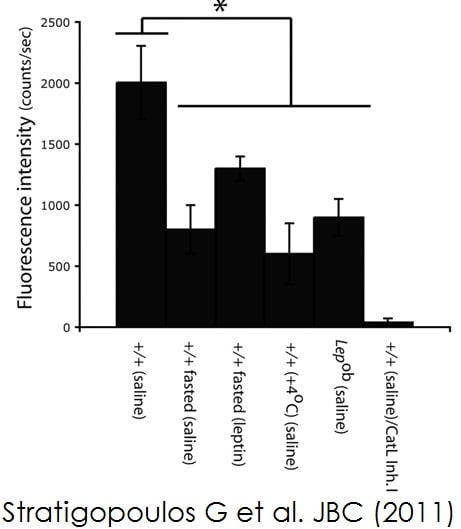Cathepsin L Activity Assay Kit (Fluorometric) (ab65306)
Key features and details
- Assay type: Enzyme activity
- Detection method: Fluorescent
- Platform: Microplate reader
- Assay time: 2 hr
- Sample type: Cell Lysate, Plasma, Serum, Tissue Lysate
Overview
-
Product name
Cathepsin L Activity Assay Kit (Fluorometric)
See all Cathepsin L kits -
Detection method
Fluorescent -
Sample type
Serum, Plasma, Cell Lysate, Tissue Lysate -
Assay type
Enzyme activity -
Assay time
2h 00m -
Species reactivity
Reacts with: Mammals, Other species -
Product overview
Abcam's Cathepsin L Activity Assay Kit is a fluorescence-based assay that utilizes the preferred cathepsin-L substrate sequence FR labeled with AFC (amino-4-trifluoromethyl coumarin). Cell lysates or other samples that contain cathepsin L will cleave the synthetic substrate FR-AFC to release free AFC, which can be measured in a spectrophotometer at Em = 505 nm. The amount of free AFC will be directly proportional to the cathepsin L activity found in the sample.
Visit our FAQs page for tips and troubleshooting. -
Notes
Cathepsin L plays a major role in antigen processing, tumor invasion and metastasis, bone resorption, and turnover of intracellular and secreted proteins involved in growth regulation. Although commonly recognized as a lysosomal protease, cathepsin L is also secreted. This broad-spectrum protease is potent in degrading several extracellular proteins (laminins, fibronectin, collagens I and IV, elastin, and other structural proteins of basement membranes) as well as serum proteins and cytoplasmic and nuclear proteins.
If you need additional Ac-FR-AFC substrate (10mM), it is avaible for purchasing as ab157769.
-
Platform
Microplate reader
Properties
-
Storage instructions
Store at -20°C. Please refer to protocols. -
Components Identifier 100 tests CL Buffer 1 x 30ml CL Inhibitor (1 mM) Red 1 x 20µl CL Positive Control (human) 1 vial CL Substrate Ac-FR-AFC (10 mM) Brown 1 x 200µl DTT 1 x 100µl -
Research areas
-
Relevance
Cathepsin L is a lysosomal cysteine proteinase that plays a major role in intracellular protein catabolism. Its substrates include collagen and elastin, as well as alpha 1 protease inhibitor, a major controlling element of neutrophil elastase activity. Cathepsin L has been implicated in several pathologic processes, including rheumatoid arthritis, muscular dystrophy, Alzheimers, cancer, myofibril necrosis in myopathies and in myocardial ischemia, and in the renal tubular response to proteinuria. Cathepsin L, which is a member of the peptidase C1 family, is a dimer composed of disulfide linked heavy and light chains, both produced from a single protein precursor. At least two transcript variants encoding the same protein have been found for its gene. -
Cellular localization
Lysosome -
Alternative names
- Cathepsin L1
- CathepsinL
- CATL
see all
Images
-
 Cathepsin L Activity Assay Kit (Fluorometric) Image from Stratigopoulos G et al., The Journal of biological chemistry vol., 286,3 (2011): 2155-70. Fig 6(A)., doi:10.1074/jbc.M110.188482.Nuclear Cathepsin L activity measured in the arcuate nucleus of: Column 1: wt lean mice, saline injected intraperitoneally; Column 2: wt fasted mice, saline injected intraperitoneally; Column 3: wt fasted mice, leptin injected intraperitoneally (1µg/g total body weight); Column 4: wt lean mice, placed in a 4C cold room for 4h; Column 5: Lepob mice, saline injected intraperitoneally; Column 6: wt lean mice, leptin and Cathepsin L inhibitor I in corn oil injected intraperitoneally (15µg/g total body weight). *,statiscally significant (pImage obtained from Stratigopoulos G et al; JBC, 2011 Jan 21;286(3):2155-70
Cathepsin L Activity Assay Kit (Fluorometric) Image from Stratigopoulos G et al., The Journal of biological chemistry vol., 286,3 (2011): 2155-70. Fig 6(A)., doi:10.1074/jbc.M110.188482.Nuclear Cathepsin L activity measured in the arcuate nucleus of: Column 1: wt lean mice, saline injected intraperitoneally; Column 2: wt fasted mice, saline injected intraperitoneally; Column 3: wt fasted mice, leptin injected intraperitoneally (1µg/g total body weight); Column 4: wt lean mice, placed in a 4C cold room for 4h; Column 5: Lepob mice, saline injected intraperitoneally; Column 6: wt lean mice, leptin and Cathepsin L inhibitor I in corn oil injected intraperitoneally (15µg/g total body weight). *,statiscally significant (pImage obtained from Stratigopoulos G et al; JBC, 2011 Jan 21;286(3):2155-70 -
Cathepsin L activity in cell lysates (duplicates +/- SD). Data from lysates corresponding to 0.5-2 million cells per well.
-
Cathepsin L activity in biological fluids (serum in the range of neat-1/27 dilution, plasma neat; duplicates +/- SD)










